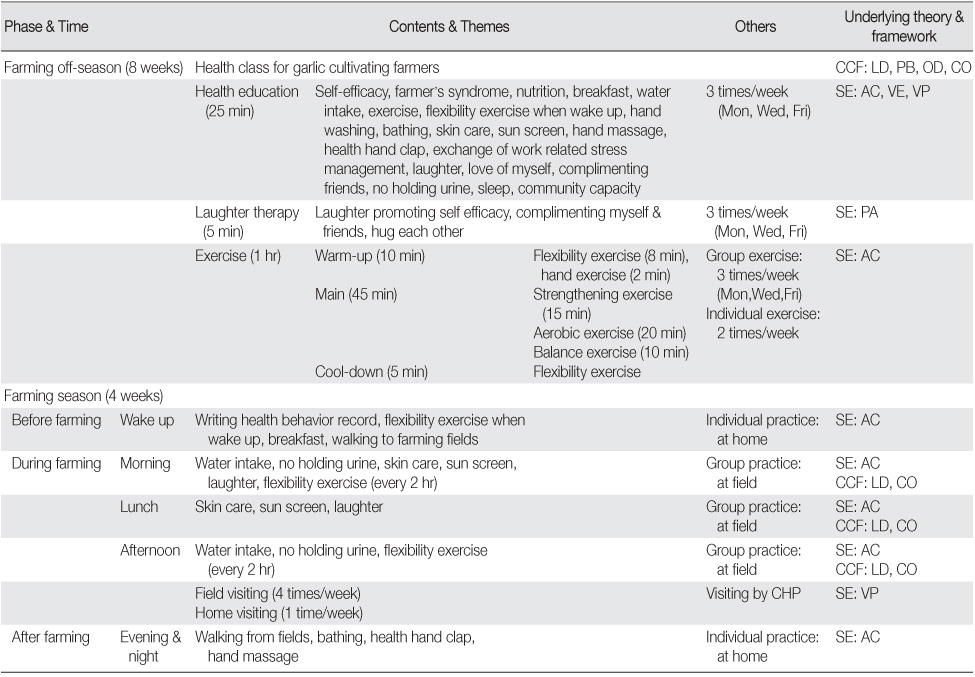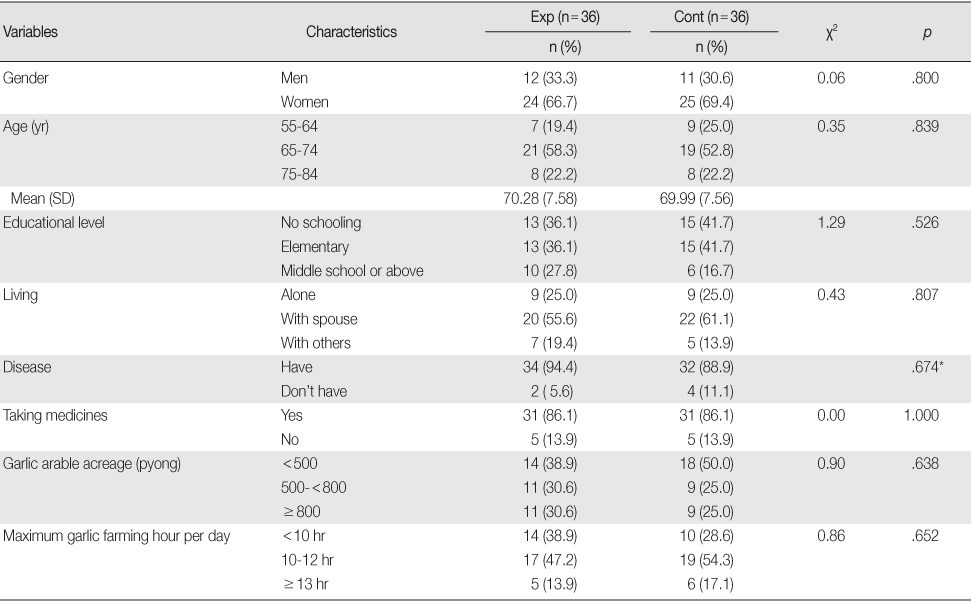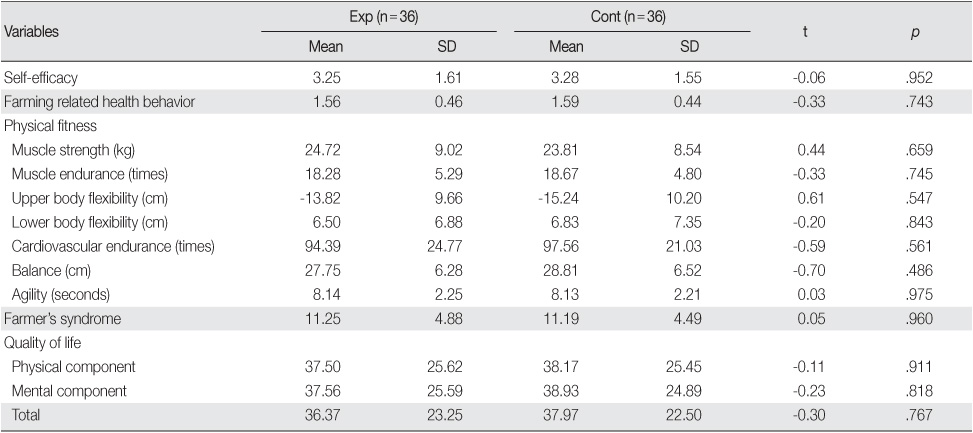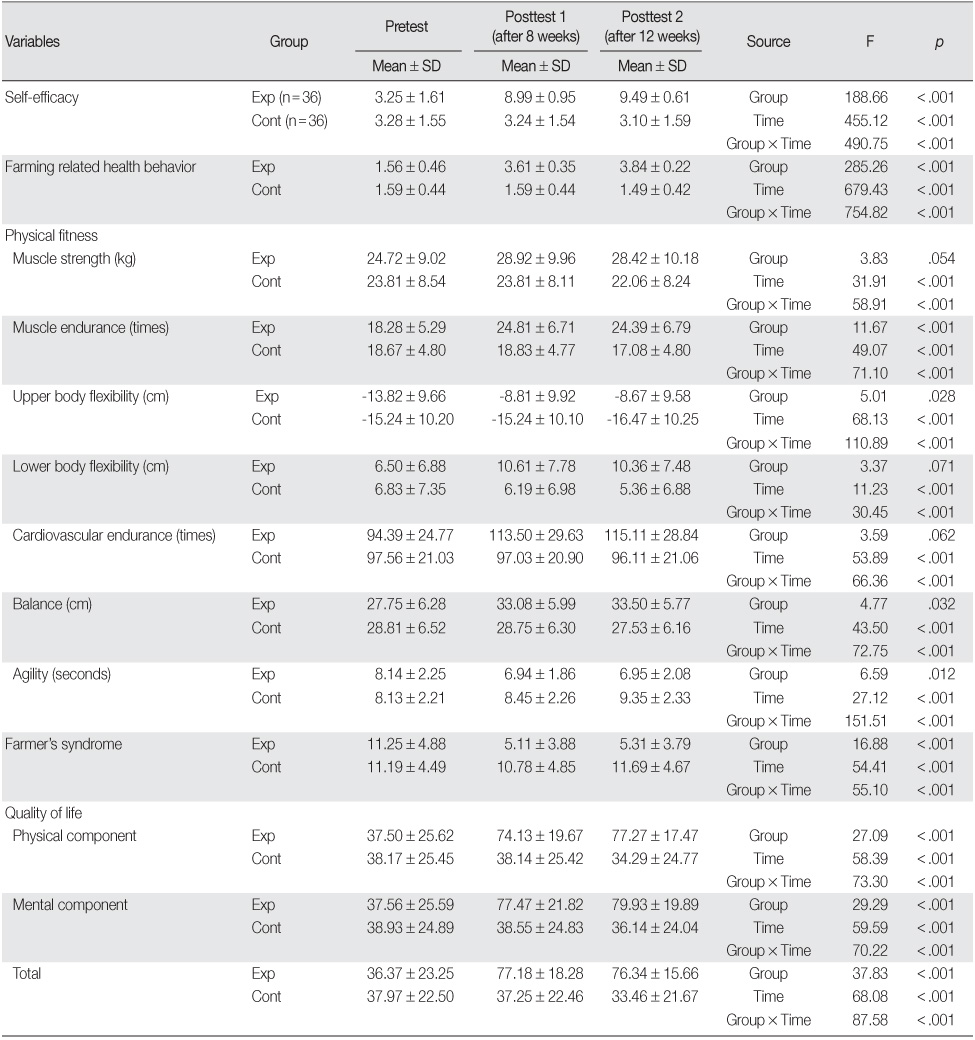Articles
- Page Path
- HOME > J Korean Acad Nurs > Volume 41(1); 2011 > Article
-
Original Article
- Effects of Community Health Promotion Project for Garlic Cultivating Farmers Based on Self-efficacy Theory and Community Capacity Building Framework
- Hyang-Sook Kim, Mee Ock Gu
-
Journal of Korean Academy of Nursing 2011;41(1):80-91.
DOI: https://doi.org/10.4040/jkan.2011.41.1.80
Published online: February 28, 2011
1Community Health Practitioner, Dongchon Community Health Center, Namhae, Korea.
2Professor, College of Nursing, Gerontological Health Research Center, Institute of Health Sciences, Gyeongsang National University, Jinju, Korea.
- Address reprint requests to: Gu, Mee Ock. College of Nursing, Gyeongsang National University, 92 Chilam-dong, Jinju 660-751, Korea. Tel: +82-55-751-8866, Fax: +82-55-751-8711, mogu@gnu.ac.kr
© 2011 Korean Society of Nursing Science
Abstract
-
Purpose
- This study was conducted to test the effects of a community health promotion project for farmers cultivating garlic. Bandura's self-efficacy theory (1986) and Chaskin's community capacity framework (2001) were used as the theoretical framework.
-
Methods
- A nonequivalent control group pretest-posttest design was used. Study participants were 72 garlic farmers (intervention: 36, control: 36). The community health promotion project consisted of health promotion program and community capacity building strategies and was provided for 12 weeks (8 during farming off-season and 4 during farming season). Data were collected between February 23 and May 31, 2009 and were analyzed using chi-square test, Fisher's exact test, t-test, and repeated measure ANOVA using SPSS/WIN 12.0.
-
Results
- For the experimental group, significant improvement was found for self-efficacy, farming related health behavior, physical fitness (muscle strength, muscle endurance, upper body flexibility, lower body flexibility, cardiovascular endurance, balance, agility), farmer's syndrome, and health related quality of life as compared to the control group.
-
Conclusion
- The findings of the study indicate that the community health promotion project for garlic farmers is effective and can be recommended as a nursing intervention for health promotion of garlic cultivating farmers.
This article is based on a part of the first author's doctoral dissertation from Gyeongsang National University.
- 1. Bandura A. Social foundations of thought and action: A social cognitive theory. 1986;Englewood Cliffs, NJ, Prentice Hall.
- 2. Chaskin RJ, Brown P, Venkatesh S, Vidal A. Building community capacity. 2001;New York, Aldin De Gruyter.
- 3. Cho BH, Jung MS, Min SH. Health promotion and community capacity. Korean Journal of Public Health. 2007;44:95–112.
- 4. Choi SH. The effect of health promotion program on health of the clients with arthritis in primary health care center. Journal of Korean Community Nursing. 2001;12:344–360.
- 5. Faul F, Erdfelder E, Lang AG, Buchner A. Statistical power analyses using G*Power 3.1: Tests for correlation and regression analyses. Behavior Research Methods. 2009;41:1149–1160.ArticlePubMedPDF
- 6. Jung YH, Seo YS, Seo NS, Rhe SA, Lee SH. A model building of rural health promotion project connected to health related community resources. 2006;Naju, Dongshin University, Management center for health promotion.
- 7. Kegler MC, Norton BL, Aronson RE. Strengthening community leadership: Evaluation findings from the California healthy cities and communities program. Health Promotion Practice. 2008;9:170–179.ArticlePubMedPDF
- 8. Kim EJ. Factors influencing the farmers syndrome. Journal of Korean Community Nursing. 2002;13:817–825.
- 9. Kim HS, Gu MO. Survey of general & farming related characteristics, health status, farmer's syndrome, farming related health behavior in garlic cultivating farmers. 2008;Unpublished manuscript.
- 10. Kim HS, Park WY. Senior fitness test manual. 2005;Seoul, Daehanmedia.
- 11. Kim IS, Kang SJ, Kim KH. The effect of self-help management program by strengthen self-efficacy on self-efficacy and the activities of daily living in stroke patients. Journal of Korean Academy of Adult Nursing. 2008;20:526–536.
- 12. Koh SB, Chang SJ, Kang MG, Cha BS, Park JK. Reliability and validity on measurement instrument for health status assessment in occupational workers. Korean Journal of Preventive Medicine. 1997;30:251–266.
- 13. Komatsuzaki O. Psychosomatic evaluation of so-called "Nofusho" symptoms. Symposium conducted at the meeting of the 4th International Congress of Rural Medicine. 1970;Tokyo, Japan.
- 14. Lee KS, Kim KR, Kim HC, Kim KS. Current status and management of agricultural industry accidents for improving quality of life of farmers. 2006;Suwon, Research center of rural resources, Rural development administration.
- 15. Lim KS. Development and evaluation of health promotion program for vinyl house farmers. 2004;Daegu, Keimyung University. Unpublished doctoral dissertation.
- 16. Meng KH. A study on the farmer's syndrome in rural residents. Human Science. 1980;4:45–51.
- 17. Ministry of Health & Welfare. Community-specific health promotion behaviors project. 2008;Seoul, Author.
- 18. Oak JS, Park WY. Effects of resistance training on fitness andequilibrium sensory function in old adults. Exercise Science. 2004;13:101–112.
- 19. Park JS. A model for health promoting behaviors in late-middle aged women. 1995;Seoul, Seoul National University. Unpublished doctoral dissertation.
- 20. Park JS. A model for health promoting behaviors in late-middle aged women. 1995;Seoul, Seoul National University. Unpublished doctoral dissertation.
- 21. Park JS, Oh YJ, Kwon SM. The effects of a tailored health promotion program on self efficacy, health problem and quality of life of rural residents. Journal of Korean Academy of Community Health Nursing. 2007;18:523–533.
- 22. Park MK, Kang KS, Kim NY. Effects of a smoking cessation program on amount of smoking and nicotine dependence and self-efficacy of smoking cessation for smoking workers. Journal of Korean Academy of Nursing. 2007;37:1073–1079.ArticlePubMedPDF
- 23. Ware JE, Sherboune CD. The MOS 36-item short-form health survey (SF-36). 1. Conceptual framework and item selection. Medical Care. 1992;30:473–483.ArticlePubMed
REFERENCES
Figure & Data
REFERENCES
Citations

- Investigation the Effect of Neuromuscular Training on Functional Sarcopenia related Index of Elderly Farmers
Woo-Young Park
Journal of The Korean Society of Living Environmental System.2025; 32(3): 305. CrossRef - Development and Effectiveness of a Community Capacity Building Program for the Wellness of Traditional Marketplace Merchants: A Pilot Study
Yeojoo Chae, Yeongmi Ha
International Journal of Environmental Research and Public Health.2021; 18(22): 12238. CrossRef - Community-based occupational health promotion programme: an initiative project for Indonesian agricultural farmers
Tantut Susanto, Iis Rahmawati, Wantiyah
Health Education.2020; 120(1): 73. CrossRef - Effects of a Yoga Program in Reducing Cardiovascular Disease Risk Factors in Workers of Small Workplaces: A Pilot Test
Won Ju Hwang, Jin Ah Kim, Ji Sun Ha
Sustainability.2020; 12(23): 10038. CrossRef - Intervention Model Development of Health Promotion for Women Workers in Traditional Marketplaces: Using Community based Participatory Action Research
Hee-Gerl Kim, Ryoun-Sook Lee, Won Ju Hwang
Korean Journal of Occupational Health Nursing.2015; 24(4): 381. CrossRef - The Effects of Dance Sports Program on Health Promotion in Rural Women
Dong-Oak Kim, Hyeon-Soon Lee, Young-Sook Kwon
Journal of Korean Biological Nursing Science.2012; 14(2): 84. CrossRef - Effects of Social Support and Emotional Intelligence in the Relationship between Emotional Labor and Burnout among Clinical Nurses
Da Won Baik, Young-Hee Yom
Journal of Korean Academy of Nursing Administration.2012; 18(3): 271. CrossRef
Community Health Promotion Project for Garlic Cultivating Farmers
CCF=community capacity framework; LD= leadership development; PB=partnership building; OD=organizational development; CO=community organizing; SE= self efficacy theory; AC=enactive attainment; VE= vicarious experience; VP= verbal persuasion; PA= eliminating physiological arousal.
Homogeneity Test of Characteristics between Experimental and Control Groups (N=72)
*Fisher's exact test; Exp=experimental group; Cont =control group.
Homogeneity Test of Dependent Variables between Experimental and Control Groups (N=72)
Exp=experimental group; Cont =control group.
Effects of Community Health Promotion Project for Garlic Cultivating Farmers (N=72)
Exp=experimental group; Cont =control group.
CCF=community capacity framework; LD= leadership development; PB=partnership building; OD=organizational development; CO=community organizing; SE= self efficacy theory; AC=enactive attainment; VE= vicarious experience; VP= verbal persuasion; PA= eliminating physiological arousal.
*Fisher's exact test; Exp=experimental group; Cont =control group.
Exp=experimental group; Cont =control group.
Exp=experimental group; Cont =control group.
 KSNS
KSNS
 E-SUBMISSION
E-SUBMISSION




 Cite
Cite

